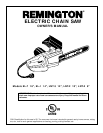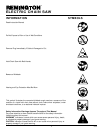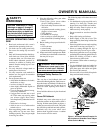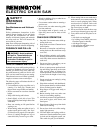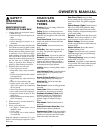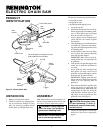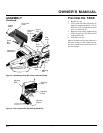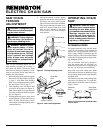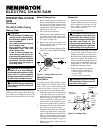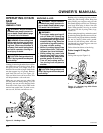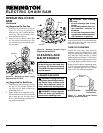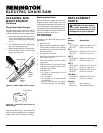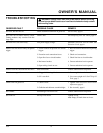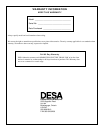
5
100583
OWNER’S MANUAL
WARNING ICON G001
SAFETY
WARNINGS
Continued
MAINTENANCE AND
STORAGE OF CHAIN SAW
1. Unplug chain saw from power source
• when not in use
• before moving from one place to an-
other
• before servicing
• before changing accessories or at-
tachments
2. Inspect chain saw before and after each
use. Check saw closely if guard or other
part has been damaged. Check for any
damage that may affect operator safety
or operation of saw. Check for align-
ment or binding of moving parts. Check
that switch turns motor on and off.
Check for broken or damaged parts. Do
not use chain saw if damage affects
safety or operation. Have damage re-
paired by authorized service person.
3. Maintain chain saw with care.
• Never expose saw to rain.
• Keep chain sharp, clean, and lubri-
cated.
• Follow steps outlined in this manual
to sharpen chain.
• Keep handles dry, clean, and free of
oil.
• Keep all screws and nuts tight.
• Inspect power cord often. If dam-
aged, have repaired by authorized
service person.
• Never carry chain saw by power cord.
• Never yank power cord to unplug it.
• Keep power cord from heat, oil, and
sharp edges.
• Inspect extension cords often and re-
place if damaged.
4. When servicing, use only identical re-
placement parts.
5. Always store chain saw
• in a high or locked place, out of
children’s reach
• in a dry place
• in a carrying case or with scabbard
over guide bar
Keep this manual for reference. It is your
guide to safe and proper operation of this
chain saw.
CHAIN SAW
NAMES AND
TERMS
Bucking Process of cutting a felled tree
or log into lengths.
Felling Process of cutting down a tree.
Felling Cut Final cut when felling a tree.
Make this cut on opposite side of tree from
notching cut.
Front Hand Guard Shield between front
handle and guide bar. Protects left hand
while using saw.
Front Handle Located at front of saw
body.
Guide Bar Metal bar that extends from
saw body. The guide bar supports and
guides chain.
Guide Bar Nose Tip or end of guide bar.
Kickback Quick backward and upward
motion of guide bar. Kickback may occur
when tip of guide bar touches an object
while chain is moving. The guide bar will
kick up and back towards operator.
Limbing Process of cutting limb(s) from a
felled tree.
Low-Kickback Chain Chain that reduces
chance of kickback as required by CSA
Standard Z62.3.
Normal Cutting Position Stance used
while making bucking and felling cuts.
Notching Cut Notch cut in tree that
directs fall of tree.
Oiler Control System for oiling guide bar
and chain.
Power Head Chain saw without chain
and guide bar. Also known as saw body.
Pushback (Kickback, Pinch) Rapid
pushback of chain saw. Pushback may
occur if chain along top of guide bar is
pinched, caught, or contacts a foreign
object.
Rear Handle Handle located at rear of
saw body.
Reduced Kickback Guide Bar Guide
bar that reduces chance of kickback.
Replacement Chain Chain that complies
with CSA Standard Z62.3 when used with a
specific saw. It may not meet CSA require-
ments when used with other saws.
Saw Chain (Chain) Loop of chain
having cutting teeth for cutting wood. The
motor drives chain. The guide bar supports
chain.
Spiked Bumper (Spike) Pointed teeth at
front of saw body beside guide bar. Keep
spiked bumper in contact with wood when
felling or bucking. It helps maintain position
of saw while cutting.
Sprocket Toothed wheel that drives chain.
Switch Device that completes or inter-
rupts electrical circuit to motor of saw.
Switch Linkage This device connects
switch to trigger. It moves switch when you
squeeze trigger.
Switch Lockout Device that reduces
accidental starting of saw.
Trigger Device that turns saw on and off.
Squeezing trigger turns saw on. Releasing
trigger turns saw off.
Trimming (Pruning) Process of cutting
limb(s) from a living tree.
Undercut An upward cut from underside
of log or limb. This is done while in normal
cutting position and cutting with top of
guide bar.



